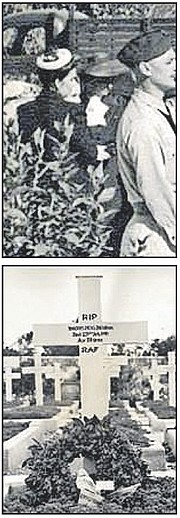By Eric Wiberg
THE build-up of New Providence into the hub of all South Atlantic air deliveries to the Allies in Africa, the Mediterranean, Middle and Far East was sudden, yet the nation’s air hub was built as Windsor Field for the RAF Ferry Command, and to support the RAF Transport Command, the No 113 Transport Wing instructors who trained over 7,000 students for the front, and to deliver over 9,000 aircraft to Africa.
The airways above The Bahamas were filled with a steady stream, mostly eastwards, of planes owned by Eastern and Pan American for the military as well as US Army Air Force transport flights to Puerto Rico, Trinidad and beyond, and thousands of US Navy training sorties over the northern Bahamas and to and from Exuma and Cuba. Some were destined for the USSR. There would be over 150 military accidents in the Bahamas from 1942-1946.
Windsor Field, which served as an ancillary to the Operational Training Unit at the older Oakes Field, was not even completed when on May 30, 1942, a Baltimore bomber took off from Oakes Field, with three men aboard for a training mission. The pilot was Henri Chouteau, his co-pilot named Cyril was well regarded in church and community, had been in the Merchant Marines and travelled widely. At 2.31pm that day. their airplane “crashed on fire 2.5 miles south-east of Satellite Aerodrome, Nassau… the aircraft took off in a tail-down position, and it is presumed that it stalled and spun inwards.”
Somewhere between Oakes Field and Windsor Field, their plane lost an engine and slammed at high speed into the bush and burst into flames. The airfield ambulances and fire trucks were not able to save them. The site of their deaths has probably neither been found nor disturbed in 80 years. It was so remote, yet accessible enough that their remains were recovered. Often anything with intelligence value was salvaged from wrecks by special teams, in this case probably not much remained of the plane.
Cyril’s wife, Patricia Jana, would have learned almost instantly; she would have heard the siren and sensed the muted terror which such a crash can spread. These first personnel to perish in a war wreck in The Bahamas were buried in the National War Cemetery, which was consecrated for the No 113 Transport Wing on October 3, 1943. The gruesome reality of what happened is inescapable in the coroner’s cause of death in the register of deaths for Western District that day; all the men died of “multiple severe injuries and severe burns a result of aircraft accident”.
At 7pm in the evening on the day after the crash, the base log recorded that “a full-service funeral was given. Dean [Sheffield] of Nassau conducted the service for CJ Somerville and the Rev Father Hagarty, RC Father for H Chouteau and JP Lynes. The commanding officer represented the ACC. Mrs Somerville, wife of CJ Somerville, was at the funeral”.
The epitaph which Patricia and his family chose for Cyril was “There is a link which death cannot sever, love and remembrance last forever”.
Henri left behind two brothers, Rene and Pierre, and a sister. Mrs Somerville arrived from Nassau less than a week after losing her husband and less than two months from marrying him. She confirmed that the funeral was held “with full military honours”, with the Dean officiating. The three men were buried with white wooden crosses at first and now have marble engraved headstones.
Sylvia Mary Moverley was from Sydenham, London when she married Deryk Cribbes. However, like her husband, she was born in an outlier of Buenos Aires. The couple were married on May 1, 1943, at Clapham Village Church, near Bedford, in England. Sylvia and Deryk moved together from Argentina to the UK and Canada for his training and her RAF work, and their ultimate home was on New Providence.
George Deryk Cribbes had enrolled in the RAF Volunteer Reserve as an Argentinean; in fact, his niece still has his uniforms. He and his younger brother, Harold, seemed to have an enjoyable childhood, alternating on teams of cricket and tennis and dressing smartly and carrying themselves with an unselfconscious ease and aplomb. He appears to have been a thoughtful person most happy when in the presence of Sylvia; he had the larger home, with the name of Isca, growing up; yet she has the largest, most irrepressible smile!
On the same island, at the same time, and seeing her man off to a training flight that day near the close of the war in Europe was a former music sensation from Kitchener, Ontario. Jean Isobel (nee Germann) Hayes was “a well-known soprano of this city whom [Al Hayes] married while home on leave last August. [She] has been in The Bahamas with him”. Al dabbled in music composition and performance as well.
On Friday, February 23, 1945, Al Hayes was the flight instructor on a B-24 Liberator. LA Birkett and AE Tomlinson were navigators. Sergeant Birch was aboard with Sergeant Holland as flight engineer, and sergeants Jackson and Richards were air gunners. Ten minutes later, the aircraft collided with another as they both entered the downwind leg of a circuit around the field. Hayes’ aircraft plummeted out of control and hit the earth south of Windsor Field aerodrome where it caught fire on the ground. There were no survivors. The LA aircraft managed to land on its belly with one injury.
Aviation historian Chris Charland sums up the events thus: “The crew was in the circuit when for some unknown reason overtook and then collided with Liberator FL994, which landed safely.”
Since Allan was a young [22] pilot instructor and the overtaking maneuver appears to have been considered by some experts as a proximate or contributory cause of the accident, for Jean and other family, the many deaths must have compounded the misery of losing a loved one.
Al Hayes had enrolled in the RCAF. The entire nine aircrew are described by the coroner in the month death register for Western District as all having suffered “multiple injuries result of aircraft accident”. The men’s remains would no doubt have been sequestered from their wives. Hayes epitaph reads “They shall mount up with wings as eagles; they shall run, and not be weary” at the Nassau War Cemetery Location West D7, close to his flight-mates.
• Visit www.tribune242. com to hear this article as a podcast.










Comments
Use the comment form below to begin a discussion about this content.
Sign in to comment
Or login with:
OpenID